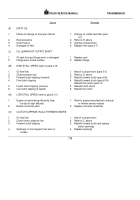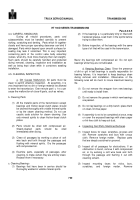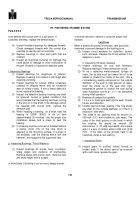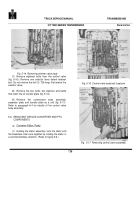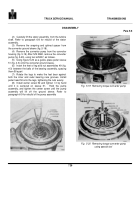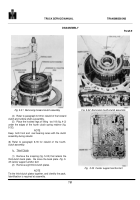TM-5-3805-254-14-P-2 - Page 729 of 894
TRUCK SERVICE MANUAL
TRANSMISSIONS
Para 4-5/4-6
(2) Inspect gear teeth for wear that may have
destroyed the original tooth shape.
If this condition is
found, replace the gear.
(3) Inspect the thrust face of gears for scores,
scratches, and burs.
Remove such defects with a soft
stone. If scratches and scores cannot be removed with a
soft stone, replace the gear.
j. Inspecting Splined Parts.
Inspect splined parts f
or stripped, twisted, chipped or burred splines. Remove
burs with a soft stone. Replace the part if other defects
are found. Spline wear is not considered detrimental
except where it affects tightness of fit of the splined
parts.
k. Inspecting Threaded Parts. Inspect parts for
burred or damaged threads. Remove burs with a soft
stone or fine file. Replace damaged parts.
l. Inspecting
Snaprings.
Inspect all snaprings for
nicks, distortion, and excessive wear. Replace snapring if
any of those defects is found. The snapring must snap
tight in its groove for proper functioning.
m. Inspecting Springs. Inspect springs for signs of
overheating, permanent set, or wear due to rubbing
adjacent parts. Replace the spring if any one of these
defects is found.
Refer to the spring chart at end of
Section 8.
n. Inspecting Clutch Plates
(1) Inspect friction-faced steel plates (internal-
splined plates) for burs, imbedded metal particles,
severely pitted faces, excessive wear, cone, cracks,
distortion, and damaged spline teeth. Remove burs,
using a soft honing stone. Replace plates which have
other defects.
(2) Inspect steel plates (externaltanged plates) for
burs, scoring, excessive wear, cone, distortion, imbedded
metal, galling, cracks, breaks, and damaged tangs.
Remove burs and minor surface irregularities, using a
soft-honing stone.
Replace plates which have other
defects.
Fig. 1-5 Method of measuring clutch plate cone
(3) The amount of cone in clutch plates is
determined by measuring the distance between the
inside diameter of the plate and a level surface (fig. 4-5).
Discard plates having excessive cone (refer to wear
limits, Section 8). When assembling a clutch pack, soak
friction-faced clutch plates in transmission fluid for at
least 2 minutes and make sure that each plate is installed
so that its cone is in the same direction as the cone of
the adjacent plates.
o. Inspecting Swaged, Interference-fit Parts. If there
is evidence of looseness due to relative motion, the
assembly should be replaced.
p. Inspecting Balls in Clutch Housings.
Inspect all
balls in rotating clutch housings for free movement.
Any
restriction could prevent the ball from seating during
clutch application.
4-6. REMOVING (OR INSTALLING) TRANSMISSION
a. Drain Oil. Drain the oil from the transmission
before removal from the vehicle (para 3-7). For better
drainage, the transmission should be warm and allowed
to drain over night. Since a p p
i c a t i o n s will differ,
consult the vehicle service manual for s p e c if i c
instructions for transmission removal and installation.
b. Check Linkages
and Lines. Make sure that all
linkages, controls, cooler lines, modulator actuator cable,
temperature connection, input and
output couplings, and
mounting bolts are disconnected before transmission
removal (also, oil filler tube and other equipment such as
attached
parking brake handle, etc). Oil lines should be
carefully placed out of the way of damage and all
openings
covered
to
keep
out
dirt.
722
Back to Top


